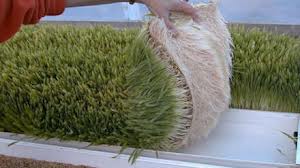Growing Animal Feed:
For Self-Sufficiency Grow
Your Own Livestock Food
Growing animal feed, also known as fodder, is a great way to cut down on the cost of feeding animals like cattle, goats, sheep, horses, and chickens. While you may not be able to grow everything your animals need, you can at least grow part of it. When it comes to smaller animals like chickens and rabbits you might be able to grow everything they need.
The Need for Feed
With the ever increasing demand for food animals, there are just not enough open pastures available to raise them on and farmers in increasing numbers are turning to raising animals like cattle indoors. The government is offering substantial subsidies to farmers who are growing animal feed, particularly corn and soy beans. When cattle are fed protein grains they are able to reach market weight faster and that shortens the cycle from birth to the dinner table and puts money in farmer’s pockets in a shorter time.
A Variety of Options
When it comes to growing animal feed there are a number of different things to choose from. Here are a few choices available:
- Sunflowers: Once grown you can feed the heads to your chickens and rabbits.
- Field Peas: Peas can be used to feed chickens and it can be used as a cover crop to discourage pests, control weeds, and to prevent soil erosion.
- Mustard: The tender young greens from the plant are good for pigs and chickens and people in Asia, North Africa, and Europe have been eating them for thousands of years.
- Squash: A variety of squash work here. You can grow Yellow Crookneck, Black Beauty, and the Long Island Cheese pumpkin. Squash is great for chickens and pigs.
- Reid’s Yellow Dent (field corn): Great for chickens and pigs, field corn is often eaten by people as well and can be almost as sweet as sweet corn.
- Sorghum: Sorghum should be grown and fed to your livestock along with corn, oats, barely, soybeans, and other grains.
- Soybeans: Most commercial feed is made from corn and soybeans so it’s a good idea to mix in other grains for a better balanced diet.
- Barley: Along with rye these grains are the first to ripen early summer. Later on you can feed your cattle with other grains that ripen in the fall.
- Oats: Along with wheat ripen in the fall.
Growing Animal Feed Hydroponically
For years people have grown vegetables hydroponically and had great success. Now some farmers in the US and Australia are growing fodder (animal feed) hydroponically. Grain that is sprouted this way is suitable for cattle, sheep, horses, goats, chickens, and lamas. You can grow your own feed this way year round, regardless of the weather, for as little as 11 cents per kg. Growing animal fodder hydroponically is the perfect solution for farmers who have limited space, drought, and shortening growing seasons.
Growing in Dry Conditions
They say necessity is the mother of invention and it is no different when it comes to growing animal feed. When land isn’t an issue and there’s plenty of money and water to go around people don’t think about alternative ways to feed their livestock. Every time there is a drought though, farmers begin thinking about different ways to grow feed. Growing hydroponically is the perfect solution for drought as well.
With hydroponics, plants are grown in a very small amount of water in a greenhouse. Feed grown in greenhouses is far more nutritious. After 7 to 10 days a young plant is ready for feeding and is more nutritious due to its age. The same plants in the pasture are much older and therefore not as good for the animals. With hydroponics, the grass is always fed when it’s at its nutritional prime.
Return from Growing Animal Feed to Backyard Farming






New! Comments
Have your say about what you just read! Leave me a comment in the box below.